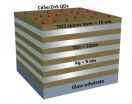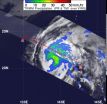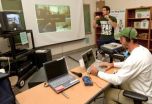(Press-News.org) AMES, Iowa – The scientific and technological literature is abuzz with nanotechnology and its manufacturing and medical applications. But it is in an area with a less glitzy aura—plant sciences—where nanotechnology advancements are contributing dramatically to agriculture.
Researchers at Iowa State University have now demonstrated the ability to deliver proteins and DNA into plant cells, simultaneously. This is important because it now opens up opportunities for more sophisticated and targeted plant genome editing—techniques that require the precise delivery of both protein and DNA to bring about specific gene modifications in crop plants. Such modifications are becoming more and more important in the face of our changing climates as new insect pests, plant diseases and soil stresses emerge where previously there were few.
While DNA delivery into cells has become routine, delivering proteins and enzymes to both animal and plant cells has proved more challenging. The Iowa State team's protein delivery advancement is an important achievement toward this end.
A research paper describing the advancement has been published online by the journal Advanced Functional Materials. The work was partially sponsored by Pioneer Hi-Bred with long-term support from Iowa State University's Plant Sciences Institute.
The Iowa State research team includes Kan Wang, professor of agronomy; Brian Trewyn, associate scientist in chemistry; Susana Martin-Ortigosa, a post-doctoral research associate in agronomy; and Justin Valenstein, a chemistry doctoral student.
Nanoparticles are tiny materials that are the size equivalent of several molecules sitting side-by-side or the size of a big virus. A single nanometer is one-billionth of a meter. The virus that causes AIDS is roughly 100 nanometers in diameter.
Using new and improved custom-built honeycomb-like mesoporous silica nanoparticles that the Iowa State team designed five years ago, the researchers have demonstrated co-delivery of functional protein and DNA into plant cells.
The first generation of these customized particles were relatively small (100 nanometers) and so the available packing spaces were unable to accommodate larger functional molecules such as proteins or enzymes. This next generation is five times the size (500 nanometers) and looks something like an ultra-fine piece of Honeycomb cereal.
The key to the researchers' success is a newly devised method for making larger uniform pouches in the custom nanoparticles. An additional modification—gold plating the entire silica particle prior to packing—improved DNA and protein binding for a more secure payload.
To test the new particle's effectiveness, Wang and her colleagues loaded the pores with a green florescent protein derived from jelly fish, which serves as a photo marker inside the plant cell. Next, these particles were coated with DNA encoding a red protein from coral. The complex was then shot into plant cells using a gene gun, a traditional gene delivery method that gets foreign material past the plant's protective cell wall.
The gold plating innovation added some greatly needed ballistic heft to the particles, ensuring their ability to cannonball through the plant cell wall once released from the gene gun.
Cells that fluoresce both red and green at the same time confirm successful delivery. The team has demonstrated success in onion, tobacco and maize cells.
The work is a tangible realization of efforts the team had in the design stage just two years ago when colleague Victor Lin of Iowa State University and the U.S. Department of Energy's Ames Laboratory unexpectedly died. "He was such a brilliant scientist," says Wang. "We all felt completely lost when we lost him."
But the team pulled together, capitalizing on the excellent training all had received from working with Lin to make this next generation particle a reality.
"We would have been unable to work out anything without each other," says Wang. "This success proves his legacy continues."
INFORMATION:
Contacts:
Kan Wang, Agronomy, 515-294-4429, kanwang@iastate.edu
Meg Gordon, Plant Sciences Institute, 608-819-6491, mbgordon@iastate.edu
Mike Krapfl, News Service, 515-294-4917, mkrapfl@iastate.edu
Newly modified nanoparticle opens window on future gene editing technologies
2012-05-28
ELSE PRESS RELEASES FROM THIS DATE:
Key gene found responsible for chronic inflammation, accelerated aging and cancer
2012-05-28
NEW YORK, May 24, 2012 – Researchers at NYU School of Medicine have, for the first time, identified a single gene that simultaneously controls inflammation, accelerated aging and cancer.
"This was certainly an unexpected finding," said principal investigator Robert J. Schneider, PhD, the Albert Sabin Professor of Molecular Pathogenesis, associate director for translational research and co-director of the Breast Cancer Program at NYU Langone Medical Center. "It is rather uncommon for one gene to have two very different and very significant functions that tie together ...
LiDAR technology reveals faults near Lake Tahoe
2012-05-28
CARNELIAN BAY, Calif. — Results of a new U.S. Geological Survey study conclude that faults west of Lake Tahoe, Calif., referred to as the Tahoe-Sierra frontal fault zone, pose a substantial increase in the seismic hazard assessment for the Lake Tahoe region of California and Nevada, and could potentially generate earthquakes with magnitudes ranging from 6.3 to 6.9. A close association of landslide deposits and active faults also suggests that there is an earthquake-induced landslide hazard along the steep fault-formed range front west of Lake Tahoe.
Using a new high-resolution ...
Device may inject a variety of drugs without using needles
2012-05-28
MIT researchers have engineered a device that delivers a tiny, high-pressure jet of medicine through the skin without the use of a hypodermic needle. The device can be programmed to deliver a range of doses to various depths — an improvement over similar jet-injection systems that are now commercially available.
The researchers say that among other benefits, the technology may help reduce the potential for needle-stick injuries; the Centers for Disease Control and Prevention estimates that hospital-based health care workers accidentally prick themselves with needles ...
Positive words: The glue to social interaction
2012-05-28
Scientists at ETH Zurich have studied the use of language, finding that words with a positive emotional content are more frequently used in written communication. This result supports the theory that social relations are enhanced by a positive bias in human communication. The study by David Garcia and his colleagues from the Chair of Systems Design is published in the first issue of the new SpringerOpen journal EPJ Data Science, and is freely available to the general public as an Open Access article.
Previous studies focused on word lengths and frequency. They demonstrated ...
University of Florida physicists set new record for graphene solar cell efficiency
2012-05-28
GAINESVILLE, Fla. — Doping may be a no-no for athletes, but researchers in the University of Florida's physics department say it was key in getting unprecedented power conversion efficiency from a new graphene solar cell created in their lab.
Graphene solar cells are one of industry's great hopes for cheaper, durable solar power cells in the future. But previous attempts to use graphene, a single-atom-thick honeycomb lattice of carbon atoms, in solar cells have only managed power conversion efficiencies ranging up to 2.9 percent. The UF team was able to achieve a record ...
Childhood cancer scars survivors later in life
2012-05-28
CHICAGO--- Scars left behind by childhood cancer treatments are more than skin-deep. The increased risk of disfigurement and persistent hair loss caused by childhood cancer and treatment are associated with emotional distress and reduced quality of life in adulthood, according to a new study led by a Northwestern Medicine advanced practice nurse, Karen Kinahan, and based on data from the Childhood Cancer Survivor Study (CCSS).
The largest study of its kind, published May 21 in the Journal of Clinical Oncology, compared scarring, disfigurement and persistent hair loss ...
'Metamaterials,' quantum dots show promise for new technologies
2012-05-28
WEST LAFAYETTE, Ind. - Researchers are edging toward the creation of new optical technologies using "nanostructured metamaterials" capable of ultra-efficient transmission of light, with potential applications including advanced solar cells and quantum computing.
The metamaterial - layers of silver and titanium oxide and tiny components called quantum dots - dramatically changes the properties of light. The light becomes "hyperbolic," which increases the output of light from the quantum dots.
Such materials could find applications in solar cells, light emitting diodes ...
NASA's TRMM satellite sees some heavy rainfall in Typhoon Sanvu
2012-05-28
Tropical Storm Sanvu strengthened overnight as forecast and is now a Typhoon in the western North Pacific Ocean. NASA's Tropical Rainfall Measuring Mission (TRMM) satellite observed that most of the rainfall is falling in the eastern half of the storm.
The TRMM satellite measured the rainfall from Typhoon Sanvu on May 24, 2012.TRMM's Microwave Imager (TMI) and Precipitation Radar (PR) data shows that Sanvu's heaviest rainfall was occurring in its northeastern quadrant where some intense storms were dropping rainfall at a rate greater than 50mm/hr (~2 inches/hr). TRMM ...
NASA satellites feed forecasters information as Bud becomes a hurricane
2012-05-28
Bud has now become the first hurricane of the eastern Pacific Hurricane Season, as NASA visible and infrared satellite imagery revealed an organized structure of spiraling thunderstorms around the eye. Watches and warnings are already in effect for southwestern Mexico as Bud nears.
The Moderate Resolution Imaging Spectroradiometer (MODIS) instrument onboard NASA's Aqua satellite captured a visible image of Hurricane Bud off the southwestern coast of Mexico on May 23 at 2035 UTC (1:35 PDT) before it reached hurricane status. The image showed the outer fringes of Bud's ...
Cyber exercise partners help you go the distance
2012-05-28
EAST LANSING, Mich. — A new study testing the benefits of a virtual exercise partner shows the presence of a moderately more capable cycling partner can significantly boost the motivation – by as much as 100 percent – to stick to an exercise program.
The research out of Michigan State University's Department of Kinesiology shows women taking part in cycling exercises exercised twice as long when working with a virtual partner, results the authors said can be used to help people meet physical activity recommendations.
The work by Brandon Irwin and colleagues is published ...




